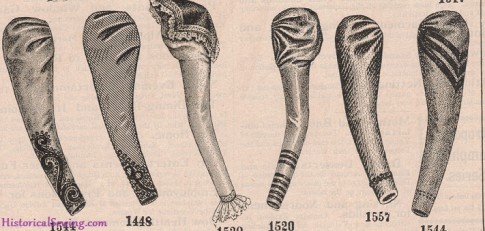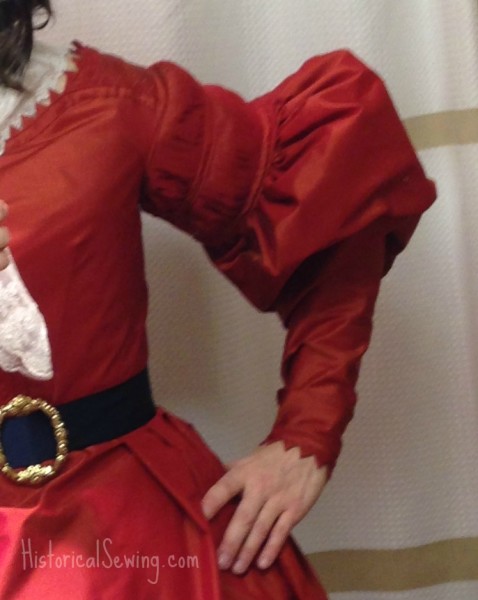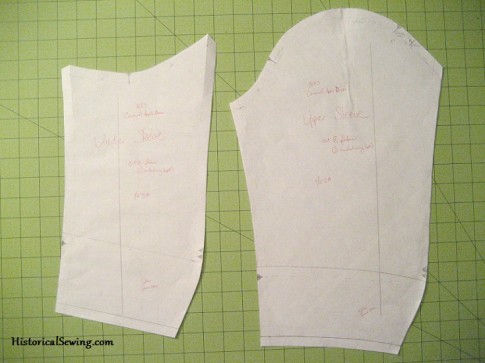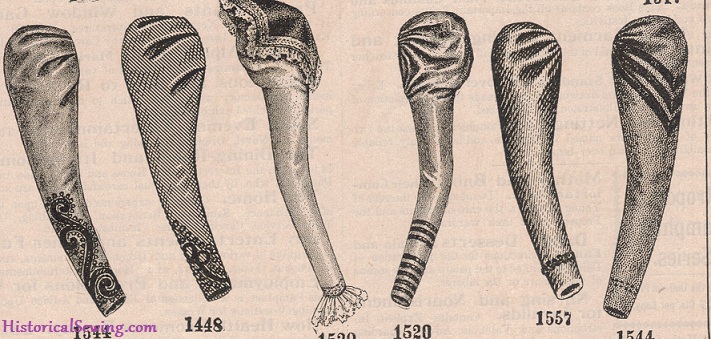
Have you done it? We’ve all been there – it’s pushing 1am and you just want to get the dang sleeves sewn in then you can go to bed.
You pick up one sleeve, look at the seams and the gathered cap, and then start pinning it into the armhole. Good. Now run it through the machine. Smooth sailing.
You pull it out and the arm is totally bent towards the back……. Argh!!!!
Think it’s now time for bed. Just as soon as I run this thing through the garbage disposal…

Sometimes I believe sleeves were created simply to aggravate sewers. The arm bends forward; there are darts for the elbow. It shouldn’t be THAT hard to sew them into a bodice.
Besides the fact that sleeves can look really cool (and are mandatory on 19th Century garments), the only good thing about them is that there are only 2: one for cursing, hemming & hawing and the other for near perfection to show off our mad sewing skills.
I’ve not had too many issues with setting in sleeves. But after one too many ground-stomping fits, I knew I had to come up with some sort of method to keep me on track with what side of my body is the right and which one is the left. (You’d think that would’ve stuck in my brain since I was about two.)
Identifying the Correct (Left or Right) Side of the Sleeve

Patterns are usually drafted for the right-hand side of the body. Meaning, when you are looking at the printing on the pattern, if you lay it on your fabric with the correct fabric side up, this will be your right side piece. (Be aware though that just because this is industry standard doesn’t mean independent pattern companies follow it.)
So how you cut your pattern from the fabric will indicate the left or right side. If there is a bend or darts in the arm, that’s a good indication it’s for the elbow or the back of the wrist. By looking at the correct side of the fabric and the bend, you’ll know if it’s for the right or left.
As soon as you’ve cut, mark the correct side of the fabric on EACH sleeve (see marking tips below).
Marks to Tell You Which End Is Up

- Notches – in general, one notch indicates the front and two notches the back. They’re usually placed a few inches up from the lowest underarm area and match to notches on the bodice. Depending on your pattern, the double notches may simply line up with the back princess seam on the bodice.
- Seam Towards the Front – in my research & sewing experience of 19th C. bodices, sleeve seams are nearly always skewed toward the front of the armpit. This is true for both one-piece and two-piece sleeves.

When working with under and upper sleeve sections, a good guideline is that the shorter seam is the one that will be in front. The longer seam is placed toward the back of the arm.
Some sleeves are cut with a mirror sleeve cap (as in the Notches photo above) where the sleeve seam is matched to the underarm seam of the bodice. If your sleeve is cut this way, use the other tips to show you which is left and right.
- Armhole Shaping – The front has a tad more concave (inside) curve shaping to it. This is for matching to the curvy bodice armhole edge. The back armhole, from the lowest underarm point up, is a bit more flat as the bodice back armhole is not as curved. This is true even in dropped sleeve styles (e.g. 1860s).
It also helps to know the sleeve cap generally has more fabric towards the top and back.
- Underarm Scoop – The very bottom center of the armhole is the first place to match to the bodice when sewing in a sleeve. Use the Armhole Shaping and Seam Towards the Front tips to help you determine which sleeve goes on which side.
Ways to Mark So You Don’t Get Turned Around (Literally)
First, hold up the cut sleeve to your arm with the fabric right side out so you can figure out which is the right and left.
A. Safety Pins Are Your Best Friend Here
Place pins on the correct sides of your sleeve. I like to place either one pin on the right hand sleeve (both pieces if it’s a 2-piece sleeve) or one on the right hand side and two on the left.
I ALWAYS put the safety pins on the correct side of the fabric. But put your pins on the same side or in the same manner that will make sense to you and that you’ll remember. (Sewing is personal, remember.)
B. Use a Marking Tool
I like a plain ol’ pencil. But don’t use a disappearing one as it’ll probably come out before you get around to setting in the sleeves. Ha!
Make a mark on the WRONG side of the fabric in the seam allowance at the top of the sleeve cap. I like to use an “R” for right and “L” for left to keep it simple.
Sleeves can be tricky. Even for the most experienced seamstress. Take your time. You get better with each pair you set in.
Above all, apply a little patience. It’ll go a long way to getting them in the right way – the first time. Most of us rush to sew them in, but slowing down will do wonders for those mad skills.
For a video tutorial on how I set in sleeves, visit this post.
More on fitting your sleeves is found in my BFF post.
How are your sleeve-setting skills? What other ways have you found helpful so you don’t get your sleeves in backwards?


Having difficulty setting short gown sleeves with no marking. Period Impression short gown pattern. Know pleats complete the shoulder and sleeve fit but positioning seams in correct location to start is escaping me. Made lost of costumes but I’m stumped.
Thanks for any assistance.
Loring Boglioli
Usually the smallest curve on the top sleeve edge attaches to bodice at the underarm/armpit. Try that.